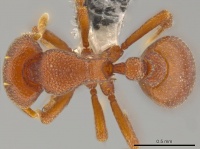Octostruma planities
| Octostruma planities | |
|---|---|

| |
| Scientific classification | |
| Kingdom: | Animalia |
| Phylum: | Arthropoda |
| Class: | Insecta |
| Order: | Hymenoptera |
| Family: | Formicidae |
| Subfamily: | Myrmicinae |
| Tribe: | Attini |
| Genus: | Octostruma |
| Species: | O. planities |
| Binomial name | |
| Octostruma planities Longino, 2013 | |
Octostruma planities is a lowland species that occurs in a wide variety of habitats including rainforest, seasonal moist forest, seasonal dry forest, and thorn scrub. Collections are from sea level to 600 m elevation. All collections are from Winkler or Berlese samples of sifted litter and rotten wood from the forest floor. (Longino 2013)
Identification
Face lacking transverse arcuate carina; basal five teeth of mandible acute; apex of labrum bilobed; face typically with 2 spatulate setae on posteromedian vertex margin, lacking elsewhere on face, mesosomal dorsum, and first gastral tergite; filiform setae lacking on petiole, postpetiole, first gastral sternite; dorsal face of propodeum flat or weakly convex over entire length; metanotal groove not impressed; HW < 0.72. Specimens from wet forest sites on the Caribbean side of the range tend to have the surface of the clypeus matte, while specimens from dry habitats in central and western parts of the range have the clypeus shiny. (Longino 2013)
Keys including this Species
Distribution
Latitudinal Distribution Pattern
Latitudinal Range: 16.4435376° to 9.90644°.
| North Temperate |
North Subtropical |
Tropical | South Subtropical |
South Temperate |
- Source: AntMaps
Distribution based on Regional Taxon Lists
Neotropical Region: Costa Rica, Guatemala, Honduras, Mexico, Nicaragua (type locality).
Distribution based on AntMaps
Distribution based on AntWeb specimens
Check data from AntWeb
Countries Occupied
| Number of countries occupied by this species based on AntWiki Regional Taxon Lists. In general, fewer countries occupied indicates a narrower range, while more countries indicates a more widespread species. |

|
Estimated Abundance
| Relative abundance based on number of AntMaps records per species (this species within the purple bar). Fewer records (to the left) indicates a less abundant/encountered species while more records (to the right) indicates more abundant/encountered species. |

|
Biology
|
Castes
Known only from the worker caste.
Nomenclature
The following information is derived from Barry Bolton's Online Catalogue of the Ants of the World.
- planities. Octostruma planities Longino, 2013: 48, figs. 1B, 3B, 5O, 13B, 35, 43 (w.) NICARAGUA.
Unless otherwise noted the text for the remainder of this section is reported from the publication that includes the original description.
Description
Worker
HW 0.58–0.71, HL 0.55–0.65, WL 0.64–0.79, CI 104–109 (n=12). Similar in most respects to Octostruma cyrtinotum and Octostruma montanis, excepting the characters noted in the Diagnosis (see the identification section above). Color orange.
Type Material
Holotype worker: Nicaragua, Región Autónoma del Atlántico Sur: 27 km WSW Rama, 12.12267, -84.46227, ±100 m, 50 m, 18 Apr 2011, 2nd growth riparian forest, ex sifted leaf litter (J. Longino#7323-s) California Academy of Sciences, unique specimen identifier CASENT0619872]. Paratype workers: same data Museum of Comparative Zoology, CASENT0625029]; same data except 13 km WNW Rama, 12.19470, -84.33665, ±100 m, 190 m, 2nd growth forest, ex sifted leaf litter (J. Longino#7322-s) National Museum of Natural History, CASENT0625016.
Etymology
The name refers to its restriction to lowland areas. It is a genitive singular noun and thus invariant.
References
- Longino, J.T. 2013. A revision of the ant genus Octostruma Forel 1912 (Hymenoptera, Formicidae). Zootaxa 3699, 1-61. doi:10.11646/zootaxa.3699.1.1
References based on Global Ant Biodiversity Informatics
- Longino J. T. L., and M. G. Branstetter. 2018. The truncated bell: an enigmatic but pervasive elevational diversity pattern in Middle American ants. Ecography 41: 1-12.
- Longino J. et al. ADMAC project. Accessed on March 24th 2017 at https://sites.google.com/site/admacsite/


